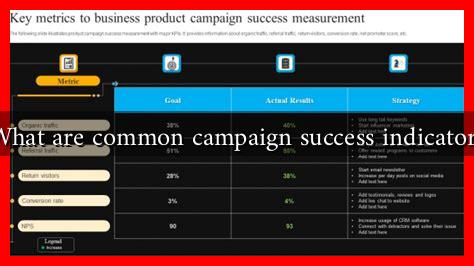-
Table of Contents
What are Common Campaign Success Indicators?
In the world of marketing and public relations, understanding the success of a campaign is crucial for future planning and strategy. Campaign success indicators (CSIs) are metrics that help organizations evaluate the effectiveness of their campaigns. These indicators can vary widely depending on the goals of the campaign, the target audience, and the channels used. In this article, we will explore some of the most common campaign success indicators, providing insights and examples to help you measure your campaign’s effectiveness.
Defining Campaign Success Indicators
Campaign success indicators are measurable values that demonstrate how effectively a campaign is achieving its objectives. They can be quantitative, such as sales figures or website traffic, or qualitative, such as customer satisfaction or brand awareness. Understanding these indicators allows marketers to make data-driven decisions and optimize future campaigns.
Common Campaign Success Indicators
Here are some of the most common campaign success indicators that organizations use to measure their campaign performance:
- Return on Investment (ROI): This is perhaps the most critical indicator for any campaign. ROI measures the revenue generated compared to the costs incurred. A positive ROI indicates that the campaign was profitable.
- Conversion Rate: This metric tracks the percentage of users who take a desired action, such as making a purchase or signing up for a newsletter. A higher conversion rate indicates a more effective campaign.
- Engagement Metrics: These include likes, shares, comments, and overall interaction with content on social media platforms. High engagement often correlates with increased brand awareness and loyalty.
- Website Traffic: Analyzing the number of visitors to your website during and after a campaign can provide insights into its effectiveness. Tools like Google Analytics can help track this data.
- Lead Generation: For B2B campaigns, the number of leads generated is a crucial indicator. This can include inquiries, sign-ups, or downloads of resources.
- Customer Retention Rate: This metric measures how well a campaign retains existing customers. A high retention rate often indicates customer satisfaction and loyalty.
- Brand Awareness: Surveys and studies can help measure changes in brand awareness before and after a campaign. Increased recognition can lead to higher sales in the long run.
Case Studies and Examples
To illustrate the importance of these indicators, let’s look at a couple of case studies:
Case Study 1: Nike’s “Just Do It” Campaign
Nike’s iconic “Just Do It” campaign is a prime example of effective use of campaign success indicators. The campaign not only increased sales significantly but also boosted brand engagement. According to a report by Statista, Nike’s market share in the U.S. athletic footwear market increased from 27% to 38% following the campaign. The engagement metrics on social media platforms skyrocketed, with millions of shares and comments, showcasing the campaign’s effectiveness in reaching and resonating with its audience.
Case Study 2: Dove’s Real Beauty Campaign
Dove’s Real Beauty campaign focused on promoting body positivity and self-esteem. The campaign’s success was measured through various indicators, including engagement metrics and brand awareness. A study by HuffPost revealed that the campaign led to a 700% increase in sales over a ten-year period. Additionally, surveys indicated a significant increase in brand perception, with many consumers associating Dove with positive social change.
Conclusion
Measuring the success of a campaign is essential for understanding its impact and guiding future marketing strategies. Common campaign success indicators such as ROI, conversion rates, engagement metrics, and brand awareness provide valuable insights into how well a campaign is performing. By analyzing these indicators, organizations can make informed decisions, optimize their marketing efforts, and ultimately achieve greater success in their campaigns. As demonstrated by the case studies of Nike and Dove, effective measurement can lead to significant improvements in both brand perception and financial performance.


